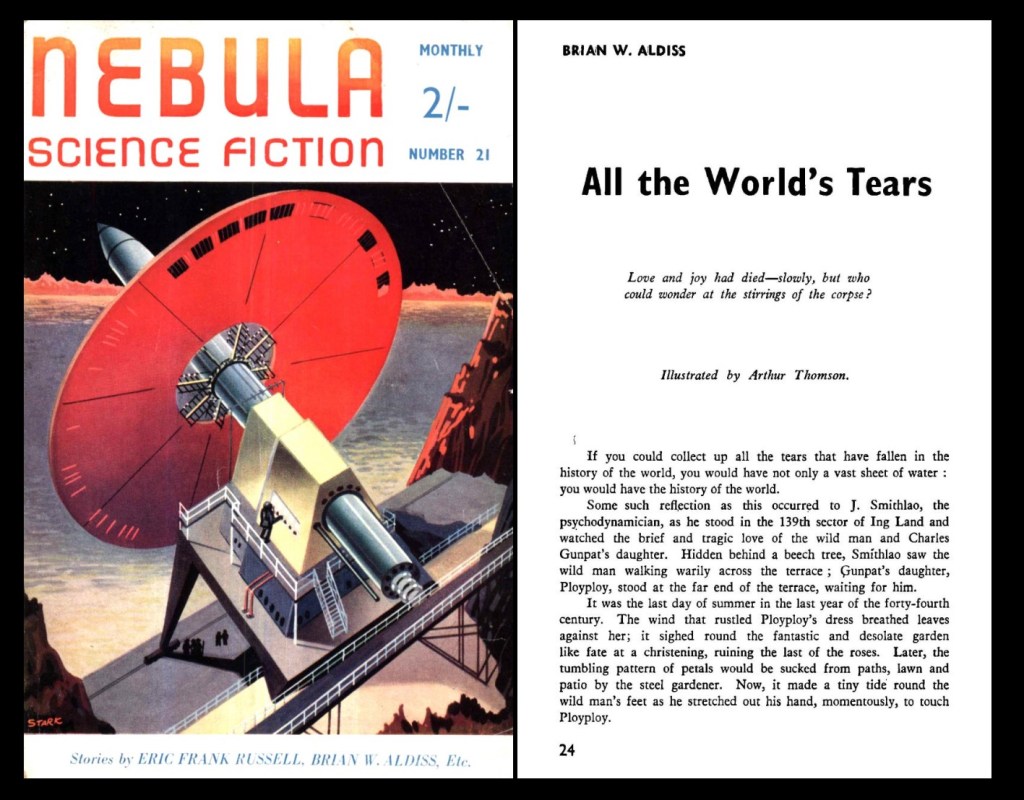
“All the World’s Tears” by Brian W. Aldiss was first published in Nebula Science Fiction 21 in 1957. It has been rarely anthologized, but frequently reprinted in collections of stories by Aldiss. Older American science fiction fans might remember reading it in Galaxies Like Grains of Sand (1960). However, that collection has been republished many times with varying numbers of stories. I don’t recommend the current Kindle edition because it leaves off the story titles, uses the theme titles instead, and runs the intros into the beginnings of the stories. It’s readable but annoying.
You can read “All the World’s Tears” in Nebula Science Fiction 21. You can read a review of Galaxies Like Grains of Sand at Science Fiction and Other Suspect Ruminations.
Galaxies Like Grains of Sand is a fixup novel with a mosaic story composed of eight or nine unrelated short stories glued together by imaginative introductions. Sort of like Simak’s City. It feels like a cross between Last and First Men and The Dying Earth.

“All the World’s Tears,” is the second story, under the theme “The Sterile Millennia.” For being such a short short story is dense with ideas, atmosphere, and imagery. The opening sequence, tells us the ending but we won’t know that until we get to the last page and read it. Aldiss has painted a future Earth of stark contrasts. The setting is the far future, the last day of summer of the 44th century. Earth no longer supports billions of humans, just hundreds remain, living in a high-tech society under the control of robots. No one is poor, but civilization is in decay.
Robots control every intent of peapods, bees, birds, and ants. The agricultural land is impoverished, yet wild mother nature is encroaching everywhere. I have to wonder if this is the mid-way point between the mid-20th century and the future of the Hothouse stories Aldiss would soon write.
Strangely, the robots do everything, yet are rather dumb. They monitor all activity, yet talk between each other in clumsy English and can be easily fooled. At one point, a man evades security robots by holding tree branches and telling the robots he’s a rose bush.
Aldiss’ prose suggests vivid scenes for paintings and films. Aldiss is quite imaginative. Both Hothouse and Galaxies Like Grains of Sand could be the basis for wonderful animated films for adults.
“All the World’s Tears” feature four human characters and several robots. The main character of focus of Ployploy. She is a young woman who is considered mentally deficient for being kind and barred from having children. However, Ployplay is well-loved by her father Charles Gunpat. She is judged a hereditary throwback because she is white and can’t express herself with hate and aggression. I can’t but wonder if Aldiss isn’t being racist here by suggesting non-white people are the genetic aggressors. Although he could also be suggesting that whiteness disappeared as the world’s population homogenized, and aggression was another trait that emerged after thousands of years of endless wars.
Observing Ployploy is a visitor, J. Smithloa, who is hired to visit Gunpat’s estate. He is a professional insulter, hired to fire up people’s aggression so they will mate and work to keep civilization going. The fourth character is a wild man sneaking onto Gunpat’s estate. He lives outside the control of the cyber-controlled state and wants Ployploy to run off with him.
Aldiss envisions the future as being extremely regulated, and high-tech, yet, falling into decay, near the end of mankind’s reign on Earth. Wild nature will soon overrun what is left of our civilization. Not only is Aldiss’ picture of our future bleak, but the couple we want to escape this horrible society die tragically.
Why did Aldiss write this story? Why is he so pessimistic? Over the past couple of years, I’ve become a fan of Brian W. Aldiss. Sometimes his works seem more adult, more mature than American science fiction. I assume in the 1950s, Aldiss extrapolated human aggression constantly evolving through natural selection into what he projects in “All the World’s Tears.” I have not read all the stories in Galaxies Like Grains of Sand, but the ones I have contain the same Darwinian cynicism about the future. In these stories, it’s a red tooth and claw existence.
I read this story years ago, and then yesterday, and again today. Each time I found more little nuggets of speculation. The story is both slight and deep. Aldiss included in his collection Man in His Times: The Best Science Fiction of Brian W. Aldiss, a collection I’m group reading on Facebook.
James Wallace Harris, 7/9/23
